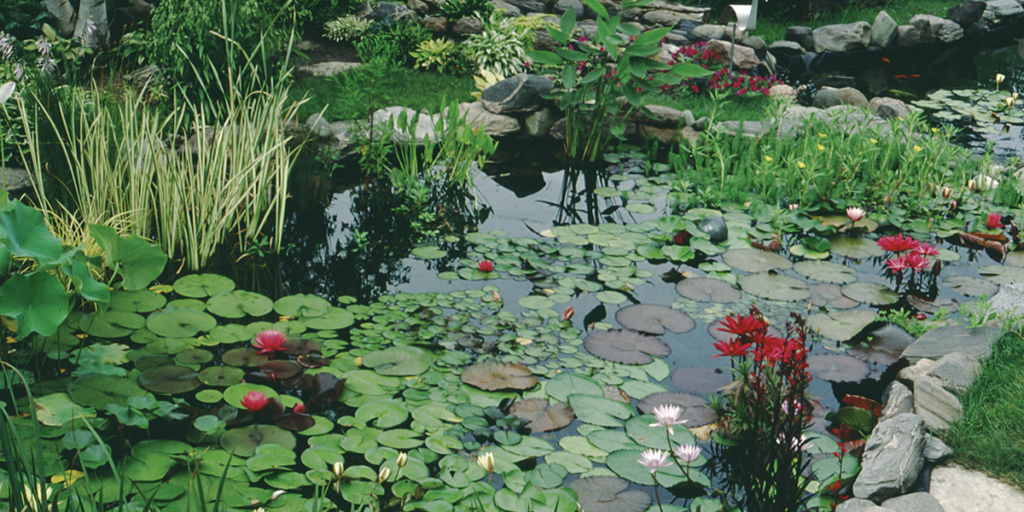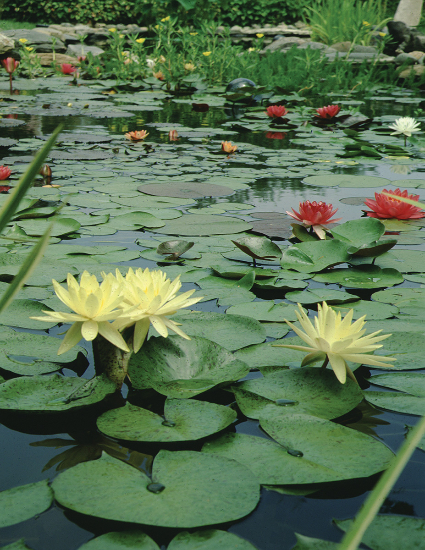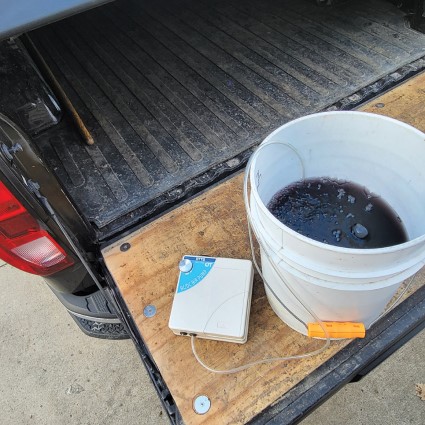Maturation of a water garden

Whenever a water garden owner asks me about water clarity or algae problems, I always ask them when the pond was installed. What has been done to improve water clarity, control algae or even clean the pond? Have they added any chemicals? If so, which ones, and when were they added?
The answers to these questions give me perspective as to which stage of aquatic succession is occurring in the water garden. An old pond that has been operating for many years, for example, should be in a “climax stage” of succession if it has been allowed to mature naturally. The concept of succession in how a pond matures was not even on my radar until I started comparing it to succession in terrestrial ecosystems. When comparing the two ecosystems, there are some differences, of course, but the concept that succession occurs in both started to make more sense.
Terrestrial Succession
Let’s discuss terrestrial succession first, since most of us have had at least one biology course in high school, where we learned the concept of plant succession. It’s quite simple. When a piece of land is cleared of all vegetation, whether by a natural disaster or by humankind, there will appear to be nothing growing. In the first week, you will get a flush of small seedling plants — almost always annual weeds like crabgrass, pig weed and whatever other annual weeds you have in your area. The following year, you will still have these annual plants, and the species may change, but they are still mostly annuals.
In the following years, you will start to see a few perennial plants become established. These plants can be grasses or even small seedling trees and shrubs, but they will still be dominated by the annual plants. As time goes on, you will see a shift to mostly perennial plants and fewer annuals. The perennial plant population will shift toward more trees or almost all grasses. Annual plants start to become scarce. The type of perennial plants depends largely on the local region, as they are influenced by available sunlight, nutrients and seed sources.
The important principle is that the ecosystem becomes more stable — the variety of plant species will be almost the same from one year to the next, with only small differences. This is what we mean by the “climax stage” of succession. However, this stability can be disrupted by animals, humans and weather patterns like drought.
Aquatic Succession
Now equate plant succession in a terrestrial ecosystem to an aquatic one. In a new water garden with virtually no plants, the first plants to show up are annuals. These are the single-celled alga or planktonic algae that manifest in a pea-green soup situation in some ponds. It may also show up as a somewhat cloudy pond. There are many hundreds of species of alga, but there are always a few that dominate. They all look almost the same unless you look at them under a microscope.
The first perennial that shows up can be string algae. We all know that plant. When string algae takes over, it dominates for available nutrients and sunlight, making the occurrence of annual planktonic algae rarer. String algae also need a substrate to grow on, like rocks or rubber liner. When the water garden is still new, the rocks and liner have not had a chance to develop a biofilm. I like to call it the patina of a pond. It can take several years for this biofilm patina to develop, and in it are perennial surface algae. This is when succession becomes more evident and can be a friend to us. Where there is a mature biofilm on the surfaces in the pond that string algae normally would grow on, that substrate becomes unavailable for string algae to establish itself.
Turning the Dial to Speed Aquatic Succession

The process of plant succession in both terrestrial and aquatic ecosystems can be somewhat controlled. We can purposely plant the types of plants we want to grow on land, and the same is true with aquatic systems. We can add all kinds of waterlilies and marginal plants, as well as floating plants. These perennial plants can change the character of an ecosystem, thus outcompeting string algae.
We can also add bacteria to an aquatic ecosystem to rapidly encourage biofilm development. Bacteria speeds up the process of nitrogen cycle succession. (Yes, there is even chemical succession in an aquatic environment.) The right kinds of bacteria are responsible for ammonia being degraded to nitrites — both still toxic to fish. Another kind of bacteria degrades nitrites to nitrates, which are normally not toxic to fish.
The focus for a water gardener should be to speed up and preserve the climax stages of succession. The healthy patina layer is our goal. We do not want to add something toxic that can kill the biofilm, nor do we want to scrub it off. This sets the patina development back to the initial stages of succession. Of course, if the biofilm is removed, we could then add more bacteria, and the succession cycle theoretically starts over. By preserving the climax stage, you can avoid the repeated cycle of all that extra work of power washing, scrubbing and adding chemicals. The patina is the pond’s natural biological filter.
In ponds where the biofilm has been preserved, it is rare to see much string algae. However, you will see string algae in streams or areas of the pond where the biofilm was allowed to dry out over winter. You can also see degradation of the patina when water circulation has been reduced in the entire pond, or even in areas I call dead zones. In these anoxic, or low-oxygen areas, you will see the sloughing off of the patina.
Succeeding With Aquatic Succession

the aeration.
Succession occurs in all ecological systems. We have been talking about plant and nitrogen-cycle succession, but critter succession is also a natural occurrence. These are the invertebrates and other small animals that naturally occur in mature ponds. One way of speeding up the cycle of critter succession is to add muck (or bottom sediment) from a healthy, mature pond to a newly established pond. You are adding not only bacteria, but also thousands of species of very small invertebrates that normally take time to colonize a new ecosystem. This is speeding up a succession of invertebrates.
This sediment is best collected from a pond that is mature, with healthy fish and plants. Take a fine-mesh net and scrape the bottom of the pond where the sediment is only an inch or two deep. Muck from a deep depth will contain fewer invertebrates, since there is less oxygen at the deeper depths. Place it in a 5-gallon bucket with a lot of the pond water. Transport with aeration, since all the critters in it need oxygen. On a warm day, it can be become anoxic quickly!
Ponds that are in the climax stage of succession, whether we are talking plants, nitrogen cycles or invertebrates, have achieved a biodiverse aquatic community. The more diversity of plants and animals we have in our ponds, the more stable they are.
It is apparent that succession takes place in every ecosystem. After seeing how it works in terrestrial ecosystems, it is easier to see that this process also works in water gardens. A lot of people think that seeing a layer of algae on the surfaces of rocks is not attractive and has to be removed. Sure, when the biofilm is not removed, you do not see the color of the rocks. However, you do see a healthy ecosystem. We can embrace this concept even more by letting go of the old paradigm that mandates clean pond surfaces. Instead, we should manage our water gardens as the functioning ecosystems we are trying to emulate.



Excelente artigo!